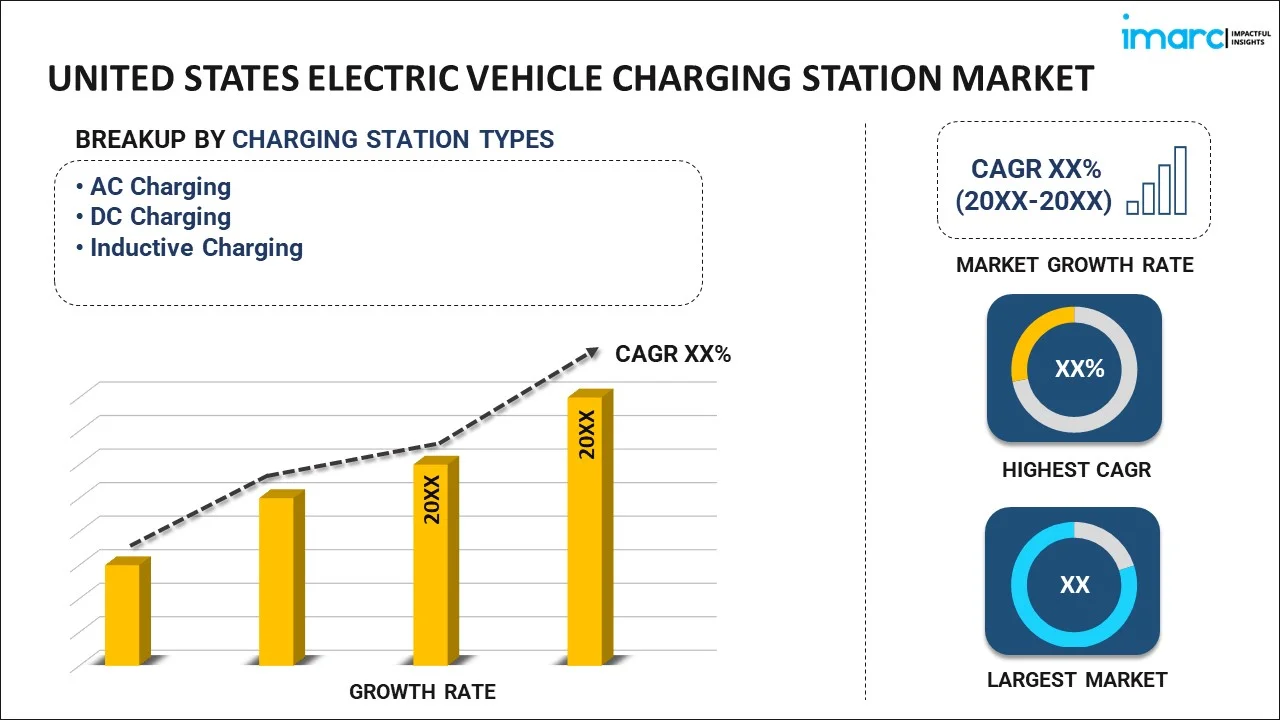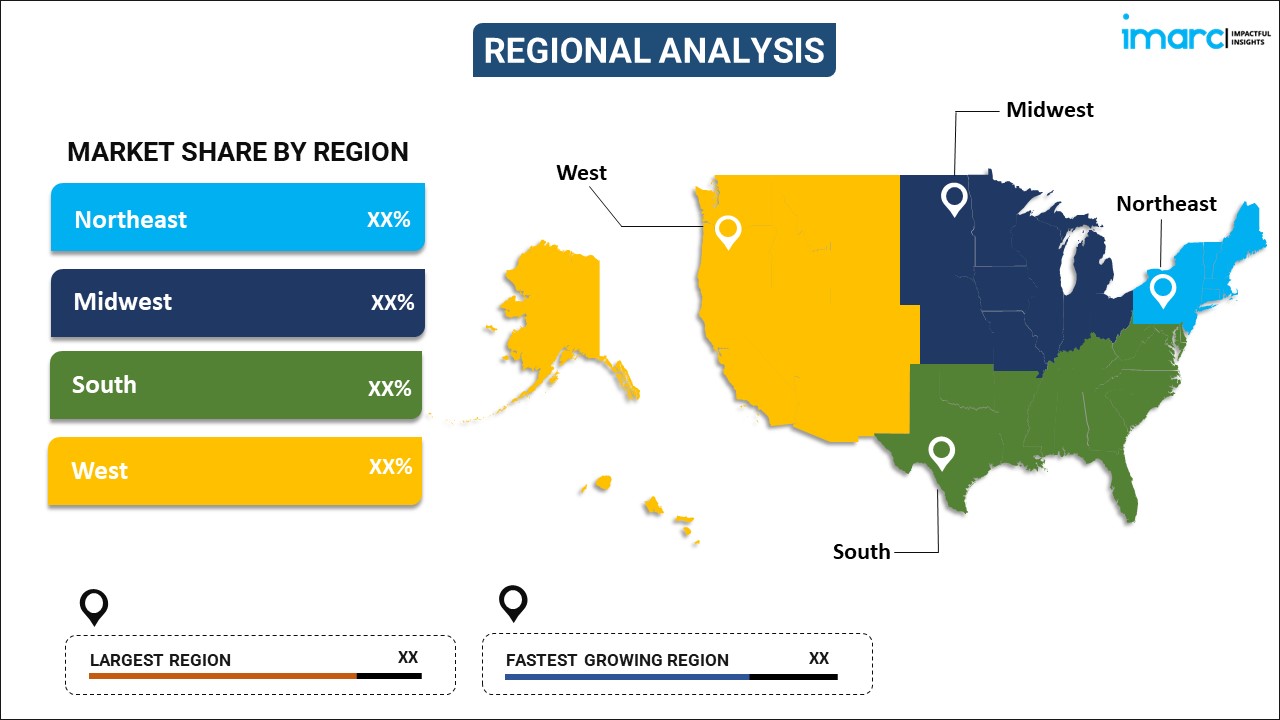
United States Electric Vehicle Charging Station Market Report by Charging Station Type (AC Charging, DC Charging, Inductive Charging), Vehicle Type (Battery Electric Vehicle (BEV), Plug-in Hybrid Electric Vehicle (PHEV), Hybrid Electric Vehicle (HEV)), Installation Type (Portable Charger, Fixed Charger), Charging Level (Level 1, Level 2, Level 3), Connector Type (Combines Charging Station (CCS), CHAdeMO, Normal Charging, Tesla Supercharger, Type-2 (IEC 621196), and Others), Application (Residential, Commercial), and Region 2025-2033
Market Overview:
United States electric vehicle charging station market size reached USD 2.5 Billion in 2024. Looking forward, IMARC Group expects the market to reach USD 33.7 Billion by 2033, exhibiting a growth rate (CAGR) of 27.6% during 2025-2033. The continuous improvements in charging technologies, such as faster charging speeds, wireless charging, and smart charging systems, which contribute to the overall appeal and convenience of electric vehicles, are driving the market.
|
Report Attribute
|
Key Statistics
|
|---|---|
|
Base Year
|
2024 |
|
Forecast Years
|
2025-2033 |
|
Historical Years
|
2019-2024
|
| Market Size in 2024 | USD 2.5 Billion |
| Market Forecast in 2033 | USD 33.7 Billion |
| Market Growth Rate (2025-2033) | 27.6% |
An electric vehicle charging station (EVCS) is a dedicated facility designed to recharge electric vehicles (EVs). These stations play a crucial role in supporting the widespread adoption of electric vehicles by providing a convenient and efficient means of replenishing their batteries. EVCS typically consists of charging infrastructure, including charging points, power supply equipment, and associated technologies. There are different types of EVCS, ranging from basic Level 1 chargers, which use standard household outlets, to more advanced Level 2 and DC fast chargers that deliver higher power levels for quicker charging. The locations of these stations vary, including public areas, workplaces, and residential complexes. The emergence of EVCS is a vital component in reducing dependence on traditional fossil fuels and mitigating environmental impacts associated with conventional vehicles. As the demand for EVs continues to rise, the development and accessibility of EVCS are pivotal for fostering the growth of clean and efficient transportation infrastructure.
United States Electric Vehicle Charging Station Market Trends:
The electric vehicle charging station market in the United States is experiencing significant growth, driven by several key factors. Firstly, the increasing regional awareness of environmental issues has led to a growing demand for sustainable transportation solutions. Consequently, governments are implementing stringent emission regulations and offering incentives to promote the adoption of EVs, fostering a conducive environment for the expansion of charging infrastructure. Additionally, advancements in battery technology have enhanced the range and efficiency of electric vehicles, addressing one of the major concerns of potential buyers. Moreover, the automotive industry's commitment to electric mobility is evident as major manufacturers are investing heavily in electric vehicle development, creating a surge in the demand for charging infrastructure. The rise of smart cities and the integration of clean energy solutions further propel the EVCS market, creating a synergistic relationship between urban planning and sustainable transportation. In conclusion, the confluence of environmental consciousness, supportive government policies, technological innovations, and the automotive industry's paradigm shift towards electric mobility collectively serve as potent drivers propelling the growth of the regional EVCS market in the coming years.
United States Electric Vehicle Charging Station Market Segmentation:
IMARC Group provides an analysis of the key trends in each segment of the market, along with forecasts at the country levels for 2025-2033. Our report has categorized the market based on charging station type, vehicle type, installation type, charging level, connector type, and application.
Charging Station Type Insights:

- AC Charging
- DC Charging
- Inductive Charging
The report has provided a detailed breakup and analysis of the market based on the charging station type. This includes AC charging, DC charging, and inductive charging.
Vehicle Type Insights:
- Battery Electric Vehicle (BEV)
- Plug-in Hybrid Electric Vehicle (PHEV)
- Hybrid Electric Vehicle (HEV)
A detailed breakup and analysis of the market based on the vehicle type have also been provided in the report. This includes battery electric vehicle (BEV), plug-in hybrid electric vehicle (PHEV), and hybrid electric vehicle (HEV).
Installation Type Insights:
- Portable Charger
- Fixed Charger
The report has provided a detailed breakup and analysis of the market based on the installation type. This includes portable charger and fixed charger.
Charging Level Insights:
- Level 1
- Level 2
- Level 3
A detailed breakup and analysis of the market based on the charging level have also been provided in the report. This includes level 1, level 2, and level 3.
Connector Type Insights:
- Combines Charging Station (CCS)
- CHAdeMO
- Normal Charging
- Tesla Supercharger
- Type-2 (IEC 621196)
- Others
The report has provided a detailed breakup and analysis of the market based on the connector type. This includes combines charging station (CCS), CHAdeMO, normal charging, tesla supercharger, type-2 (IEC 621196), and others.
Application Insights:
- Residential
- Commercial
A detailed breakup and analysis of the market based on the application have also been provided in the report. This includes residential and commercial.
Region Insights:

- Northeast
- Midwest
- South
- West
The report has also provided a comprehensive analysis of all the major regional markets, which include Northeast, Midwest, South, and West.
Competitive Landscape:
The market research report has also provided a comprehensive analysis of the competitive landscape. Competitive analysis such as market structure, key player positioning, top winning strategies, competitive dashboard, and company evaluation quadrant has been covered in the report. Also, detailed profiles of all major companies have been provided.
United States Electric Vehicle Charging Station Market Report Coverage:
| Report Features | Details |
|---|---|
| Base Year of the Analysis | 2024 |
| Historical Period | 2019-2024 |
| Forecast Period | 2025-2033 |
| Units | Billion USD |
| Scope of the Report | Exploration of Historical Trends and Market Outlook, Industry Catalysts and Challenges, Segment-Wise Historical and Future Market Assessment:
|
| Charging Station Types Covered | AC Charging, DC Charging, Inductive Charging |
| Vehicle Types Covered | Battery Electric Vehicle (BEV), Plug-in Hybrid Electric Vehicle (PHEV), Hybrid Electric Vehicle (HEV) |
| Installation Types Covered | Portable Charger, Fixed Charger |
| Charging Levels Covered | Level 1, Level 2, Level 3 |
| Connector Types Covered | Combines Charging Station (CCS), CHAdeMO, Normal Charging, Tesla Supercharger, Type-2 (IEC 621196), Others |
| Applications Covered | Residential, Commercial |
| Regions Covered | Northeast, Midwest, South, West |
| Customization Scope | 10% Free Customization |
| Post-Sale Analyst Support | 10-12 Weeks |
| Delivery Format | PDF and Excel through Email (We can also provide the editable version of the report in PPT/Word format on special request) |
Key Questions Answered in This Report:
- How has the United States electric vehicle charging station market performed so far and how will it perform in the coming years?
- What has been the impact of COVID-19 on the United States electric vehicle charging station market?
- What is the breakup of the United States electric vehicle charging station market on the basis of charging station type?
- What is the breakup of the United States electric vehicle charging station market on the basis of vehicle type?
- What is the breakup of the United States electric vehicle charging station market on the basis of installation type?
- What is the breakup of the United States electric vehicle charging station market on the basis of charging level?
- What is the breakup of the United States electric vehicle charging station market on the basis of connector type?
- What is the breakup of the United States electric vehicle charging station market on the basis of application?
- What are the various stages in the value chain of the United States electric vehicle charging station market?
- What are the key driving factors and challenges in the United States electric vehicle charging station?
- What is the structure of the United States electric vehicle charging station market and who are the key players?
- What is the degree of competition in the United States electric vehicle charging station market?
Key Benefits for Stakeholders:
- IMARC’s industry report offers a comprehensive quantitative analysis of various market segments, historical and current market trends, market forecasts, and dynamics of the United States electric vehicle charging station market from 2019-2033.
- The research report provides the latest information on the market drivers, challenges, and opportunities in the United States electric vehicle charging station market.
- Porter's five forces analysis assist stakeholders in assessing the impact of new entrants, competitive rivalry, supplier power, buyer power, and the threat of substitution. It helps stakeholders to analyze the level of competition within the United States electric vehicle charging station industry and its attractiveness.
- Competitive landscape allows stakeholders to understand their competitive environment and provides an insight into the current positions of key players in the market.
Need more help?
- Speak to our experienced analysts for insights on the current market scenarios.
- Include additional segments and countries to customize the report as per your requirement.
- Gain an unparalleled competitive advantage in your domain by understanding how to utilize the report and positively impacting your operations and revenue.
- For further assistance, please connect with our analysts.
 Request Customization
Request Customization
 Speak to an Analyst
Speak to an Analyst
 Request Brochure
Request Brochure
 Inquire Before Buying
Inquire Before Buying




.webp)




.webp)












